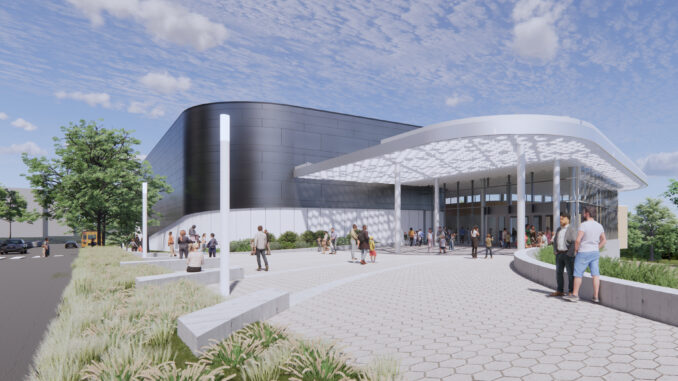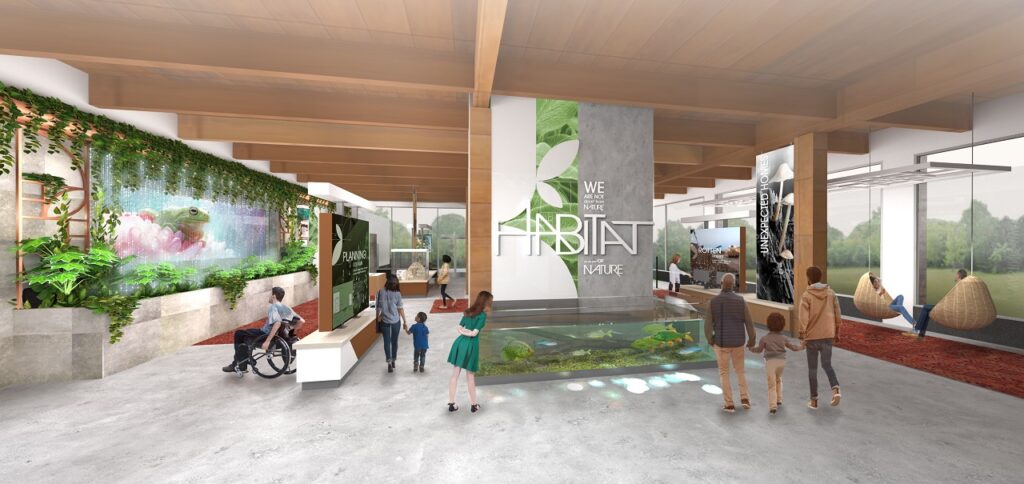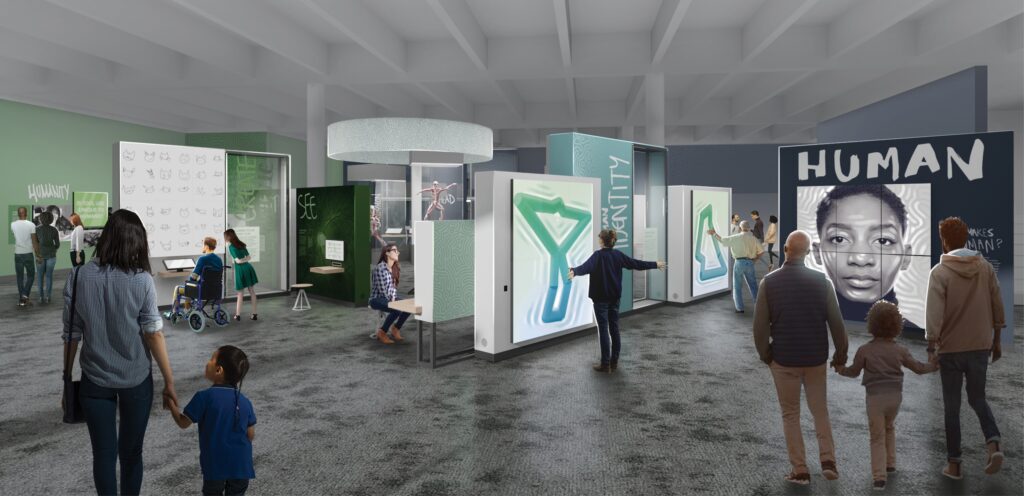
THE FUTURE IS HERE
By Karen Feldman
To say Daphne Boyle is looking forward to the upcoming Northern Virginia Science Center is an understatement. She is eagerly following every update about the museum’s construction here in Loudoun County.
“It’s great,” Boyle said. “It’s about time this area had something STEM-related.”
STEM, of course, stands for science, technology, engineering and mathematics – and it’s become a focus for many parents, schools and organizations preparing the next generation for careers in these fields.
Born in the Philippines, Boyle grew up in the Richmond area in a STEM-focused family, and both her parents were doctors. Today she lives in the Broadlands and is a school nurse at St. Theresa Catholic School. She also has two girls – Gracie, 9, and Lilly, 7 – and she’s excited to expose them to STEM topics when the science center opens.
“Early exposure is always important, and children learn more with hands-on and interactive exhibits,” Boyle said.
Currently, Northern Virginia has the distinction of being the world’s largest data center market and boasts 2½ times more computer science graduates than similarly tech-heavy hubs such as New York, Seattle and San Francisco, according to the Northern Virginia Technology Council.
Yet it also holds the dubious distinction of being the largest U.S. metropolitan area without an interactive hands-on museum for children.
“We have 3 million people who live in the region, and we don’t have a science center,” said Adalene “Nene” Spivy, CEO of the Northern Virginia Science Center Foundation. “Our children go to centers in Baltimore and Washington and Philadelphia, but it’s expensive and, for many families, it’s out of reach.”
The foundation Spivy leads wants to correct this “oversight.” The nonprofit is leading the effort to build a huge science center right here in Loudoun County – on the border between Ashburn and Sterling.
It’s a large, complex project that has been in the works for years. With the groundbreaking officially happening in March, Ashburn Magazine took a deeper look into the past – and future – of the Northern Virginia Science Center.
RIGHT NOW
After 15 years of research, brainstorming and fundraising, the $100 million science center is – at long last – transforming from a visionary aspiration to brick-and-mortar reality. The 70,000-square-foot structure is under construction at the Kincora development off Russell Branch Parkway near Route 7 and Route 28.
The center, expected to open in late 2027, aims to captivate children and interest them in embracing science-related fields as demand for STEM professionals is expected to grow substantially through 2033.
Between 2023 and 2033, the U.S. Bureau of Labor Statistics projects a 10.8% increase in STEM jobs, compared to a 4.9% growth rate for all other careers. The largest increases are expected in statistics (35.4% growth), information security (33.3%), epidemiology (29.6%) and computer science (21.9%).
These are the jobs the center hopes to help fill by inspiring future engineers, scientists, mathematicians and technology wizards. Beyond that, its creators want visitors to understand that “science is everything and everything is science.”
Craig Ridley, the founder of Catalyst Capital Group, has served on the foundation board for eight years. A donor, he has helped bring in corporate dollars, too. Ridley has high expectations for the center.
“We have an incredible opportunity to make an enduring impact on the region with a world-class facility,” he said. “In addition to serving as an amazing interactive science center … for learners of all ages, it will significantly contribute to this region’s workforce development as a resource center with innovative STEM programming.”
DISCOVERY PROCESS
The first step in the years-long planning process was speaking with people of all ages to find out what interested them.
“The museum is a reflection of the community and what it aspires to be,” Spivy said. “I didn’t want to design a museum in a vacuum. We took all the community input and crystallized it into thematic areas, took those and narrowed it into five big themes. The topics that we came up with encapsulate a lot of STEM activities, but you don’t necessarily have to be a STEM lover. You’re still going to be curious about what it means to be human.”
Exhibits will blend disciplines, which means there will be no potentially intimidating galleries labeled physics, chemistry or mathematics. Instead, the center will have five galleries with hands-on exhibits and immersive workshops that afford children the opportunity to engage with science, with a helping of the arts in the mix.
“More and more arts and sciences are very integrated, and are really speaking to the hearts of all humans when you approach it this way,” Spivy said. “We all want interactive-ness. My theory is that the best exhibits are fun for kids, but if you’re designing them well, they are really for adults.”=
They see proof of that theory at the Children’s Science Center Lab, a “temporary” museum that the foundation opened at the Fair Oaks Mall in Fairfax County in 2015. This was a chance to engage with the community and gain real-time feedback in an actual museum environment.
And sometimes it wasn’t just the children who were amazed by it. “We have fathers who won’t leave,” said Dorothy Ready, the foundation’s director of communications.
The mall museum will close when the science center in Ashburn opens.
ECONOMIC IMPACT
Spivey has been CEO since 2010, getting involved when the Junior League of Northern Virginia donated to the fledgling project. “I believed in the mission but was also involved in securing the investment of the Junior League,” she said.
A public/private partnership made the project possible, even though it prolonged the planning process.
“In some ways, getting the right public/private partnership in place has been part of what took so long,” Spivy said.
The partnership is a collaboration in which public and private entities share responsibility for fundraising, construction and operation of the center. Loudoun County and the state of Virginia have both provided funding, and the Science Museum of Virginia in Richmond shares resources, including its team of museum experts and administrative staff. The partnership also includes the Kincora development, which donated the five acres on which the science center will sit.
Beyond the educational punch this center will deliver, it’s also predicted to have a positive economic impact on the region. An economic analysis by Dr. Steve Fuller, professor of public policy and regional development at George Mason University, determined that the museum would generate roughly $118 million in the short term during the construction phase – and $11 million annually once it’s open.
For Daphne Boyle, 2027 can’t come soon enough. If she can swing it, she hopes to be at the museum’s opening day with her daughters.
“Loudoun County has so many fun things to do, but none of it is really science-based. I think the science center is going to be a cool field trip for the kids.”
Karen Feldman is a career journalist who has worked as an editor and writer at newspapers and magazines around the country.
=====
COMING ATTRACTIONS
A sampling of the planned galleries and exhibits:
Wonder: Dedicated to young learners and families, many of the activities from the current Lab at the mall will be found here: an experiment hub, tinker shop and programmable orchestra will allow visitors to let their imaginations soar. Exhibits here are designed to encourage creativity, exploration and discovery.
Flow: The constant flow of matter and energy will be presented in fully interactive installations. Exhibits will help visitors visualize mathematical principles and the flow of data and information – concepts that have been abstract and hard to experience until now.
Helios: Explores the solar system and beyond with a focus on the sun’s influence on seasons and ecosystems, life and even our concept of time. An immersive rocket launch exhibit brings science history to life by simulating the sights, sounds and physical impacts as if visitors were viewing a launch closeup.
Habitat: Explore the surprising way in which human activity and nature are inextricably woven. It also examines our love of nature.
Human: Who we are and what makes us human. The gallery will encourage guests to explore what they think they know about their bodies, minds and communities, while revealing unexpected aspects of being human.
Other highlights: The Rain Wall, Innovation Hub and Idea Lab and a human-sized great blue heron nest in which children can sit.
=====
TIMELINE
2004: Founded as Children’s Museum of Northern Virginia
2006: Partners with Junior League of Northern Virginia to advance mission
2012: Launches school outreach programs
2014: Receives land donations from Kincora for future science center
2015: The Children’s Science Center Lab opens in Fair Oaks Mall
2018: Science Center included in governor’s budget
2019: Public-private partnership, lead gift confirmed
2020: Exhibit and architectural design begin
2022: Building and exhibit design completed
2024: Knowledge Drive – the road leading to the museum site – completed
2025: Construction begins
2027: Anticipated opening
Source: Northern Virginia Science Center Foundation
=====
FAST FACTS
WHAT: Northern Virginia Science Center, an interactive science center
WHERE: Kincora development, near Routes 7 and 28
SIZE: 5-acre property; 70,000-square-foot structure and access to 200 adjoining acres of stream valley parkland and nature trails
PARTNERSHIP: Pivotal partners include the state of Virginia, Loudoun County, Kincora and Northwest Federal Credit Union, contributing resources and expertise
REACH: Expected to serve 300,000-plus visitors annually
COST: $100 million, with about $3 million still to raise
ECONOMIC IMPACT: $118 million in the short term and $11 million annually upon completion
Source: Economic analysis by Dr. Steve Fuller, George Mason University, Northern Virginia Science Center Foundation
=====
ANOTHER MUSEUM?
The Northern Virginia Science Center isn’t the only museum slated for the Kincora development. There are also plans for the National Museum of Intelligence and Special Operations. This facility will “honor Americans who have served at the ‘the tip of the spear’ as our nation’s first line of defense” – meaning our nation’s spies who worked in departments such as the OSS, which operated during World War II and was the precursor to the CIA.
The team working on the National Museum of Intelligence and Special Operations is currently fundraising for the project. You can learn more at nationalintelligencemuseum.org.




